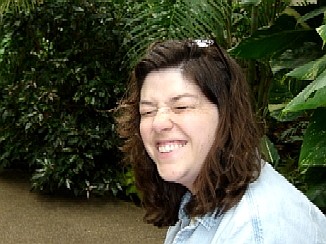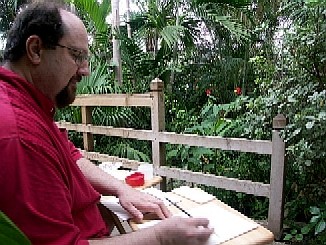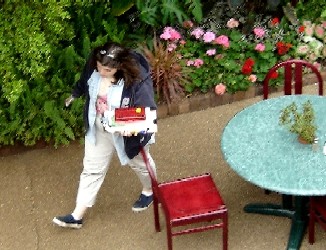I went painting today at the local Botanical Center.  Stefanie joined me for this, and it was fun. She tried her first watercolor (did well!) and otherwise sketched and took some great photos, which I'll post later. We also met a person who has her work in the Smithsonian. Her name is Jean Wilson, and she does extraordinary calligraphy.  While Stefanie charmed the little kids who stopped by our little section of paved path to see what we were doing (she even coaxed one cute little girl to sketch along with us and submit her work for the contest!), I tried to figure out how to paint what lie in front of me. I learned a couple of things and had some thoughts on the drive home... Most of my painting thus far has been from photos. Today, I did it "plein air" style, or painting in one sitting from real life. Very different. I've mentioned before that painting is a process of constantly forcing oneself to see things as they are. You can't just see a ball and then spend five minutes at the canvas. There's no such thing as a photographic memory when painting. Memory is reconstructive and once you start reconstructing, you're guessing. Hence, the constant scanning of the subject and the few brushstrokes each produces. Well, that's tiring mental work, and in one sitting, it's not something I'm accustomed to doing. Holy cow, my hat goes off for all of those who do this a lot. I didn't finish mine... I needed a break. I will finish it later from photos that I took, but I need to do a lot more of this. I started well, I think, but as I grew tired of the constant scanning and checking and rechecking, I found myself guessing more and just throwing the brush around in a way that felt lazy. I don't do that when painting from photo. Why? Thinking about it on the way home, an analogy came to me. When I'm sitting in front of my subject, painting plein air, I lose perspective. I mean frankly, there is so much that I could paint. The far wall, the plants that are closer, the bridge, the plants in front of the bridge, the people wandering around, the plants behind the main flowers that I wanted to paint, the flowers that I wanted to paint... our eyes can focus on objects far and on objects near, and it's all important. Not so with a photograph. It's much easier to see the main elements and not get lost in everything else. Kind of like how friends can tell you that you're engaged to the wrong person, but you have a harder time seeing their point. They see you like a photograph, but you're living it and there is so much to focus on. "Dude, she's not right for you."
"You just can't see her like I do." Exactly. That's the point. It's subjectivity and objectivity. I'm sure that you've been told before that you're too close to something to see it as it is. Painting from real life is just like this, ironically enough. I think this is why Picasso painted as he did. He literally painted it as he saw it - even if his model moved or if his perspective changed - whether it made sense to others or not. Painting is a growth experience. I look forward to finishing what I started today and then sometime this week, begin to paint what I see and stop working from photos for a while. ETC: Pictures...    |